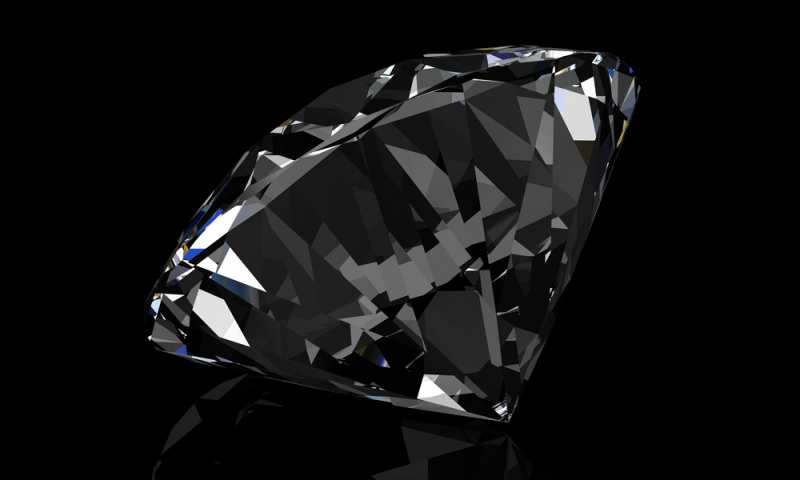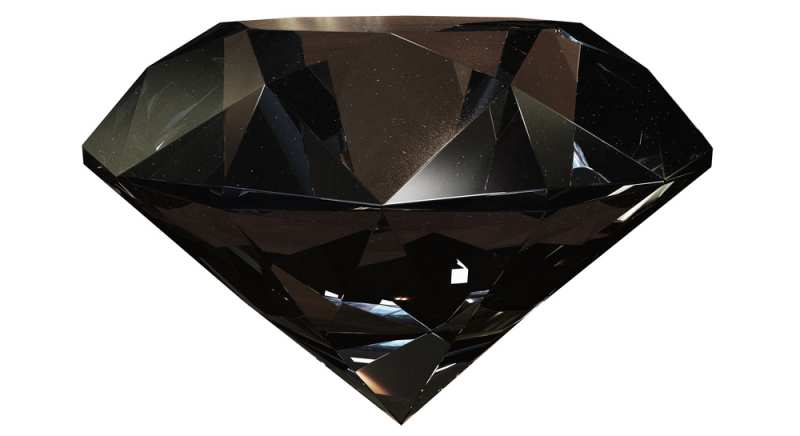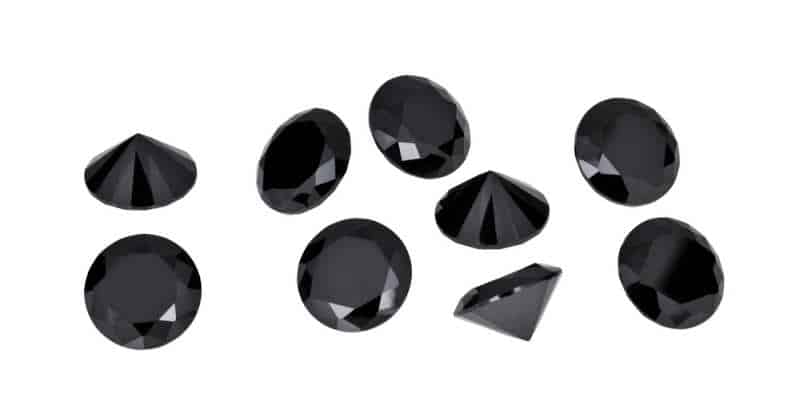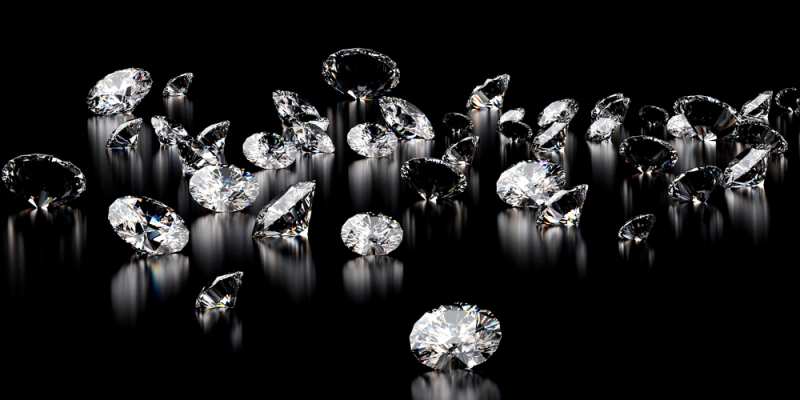The allure of black lies in its enigmatic and sophisticated appeal. The same goes for black diamonds, renowned for their dark glamour and exquisite beauty.
Yet, you may wonder why black diamonds are often considered inexpensive. The answer to this question depends on whether the black diamond is natural or not, as it is the primary factor determining its value.
In this article, we will explore the distinctions between natural and synthetic black diamonds and delve into other factors that influence their pricing. So, without delay, let us delve into the world of black diamonds and uncover the answers to these and more intriguing questions.
DESIGN YOUR OWN ENGAGEMENT RING: START WITH A SETTING OR START WITH A DIAMOND. IT’S REALLY UP TO YOU!

History Of Black Diamonds
Black diamonds, also known as carbonados, have a fascinating history. Discovered in Brazil and the Central African Republic in the 19th century, these dark gems hold a distinct allure.
Formed approximately 2.6 to 3.8 billion years ago, black diamonds are natural polycrystalline diamonds. They are primarily mined from stream beds, with around three metric tons extracted to date.
Throughout different cultures, black diamonds have held varied beliefs and symbolism. In India, they were seen as cursed due to their resemblance to snake eyes. On the other hand, in Italy, there was a belief that touching a black diamond could save a failing marriage.
During the 19th and 20th centuries, jewelers often deemed black diamonds too challenging to cut and polish, relegating them to industrial use. However, their popularity grew when the founder of a Swiss jewelry house introduced a collection of black diamond jewelry and watches in 1996.
Today, black diamonds are used in both women’s and men’s jewelry, offering a unique and captivating option. It’s important to note that black diamonds differ from other colored diamonds. They possess an exceptionally high number of inclusions, resulting in their distinctive black appearance. These inclusions, rather than specific chemical impurities, contribute to their unique character.

Types Of Black Diamonds
There are two primary types of black diamonds: natural black diamonds and treated black diamonds. Natural black diamonds, like any other gemstone, hold significantly more value and desirability.
In contrast, treated black diamonds are less valuable as they start as white diamonds with numerous inclusions and a dull grey appearance. Initially, they hold minimal worth and are commonly used for industrial purposes. Through heat, pressure, and irradiation treatments, these white diamonds can be transformed into black diamonds.
On the other hand, natural black diamonds acquire their black color during their formation process. They possess a high concentration of inclusions, which cluster together, giving them a black, metallic appearance. The natural origin of these black diamonds makes them exceptionally rare and, therefore, more valuable than their treated counterparts.
The black color of black diamonds is believed to be attributed to graphite. The high level of inclusions, which are small imperfections affecting the gemstone’s appearance, is responsible for altering the color of black diamonds.
In terms of hardness, diamonds are renowned for their durability, ranking a perfect 10 on the Mohs scale. However, black diamonds have a slightly different structure. They consist of many small crystals fused together in random formations.
Although black diamonds are also rated as a 10 on the Mohs scale, they are known to be even harder than most colorless diamonds. Prior to their use in jewelry, black diamonds served various functions due to their exceptional durability.

The 4 C’s
In general, the quality and value of diamonds, including black diamonds, are assessed based on cut, clarity, color, and carat weight.
Cut: The cut refers to the style and shape of the diamond, including its symmetry, proportions, and reflective qualities. Cutting black diamonds can be challenging due to their densely packed inclusions and cavities that hinder light transmission. Expert craftsmanship is required to achieve a high-quality cut, which adds value to the black diamond.
Clarity: Unlike clear diamonds that are rated on a color scale, black diamonds are not judged based on clarity. The high number of inclusions in natural black diamonds prevents them from refracting light in the same way as other diamonds. Therefore, clarity is not a determining factor for their quality and value.
Color: Natural black diamonds, along with red and white diamonds, have only one level of intensity known as fancy black. Their completely opaque nature means they do not vary in tone, hue, or intensity. As a result, grading systems used for other colored diamonds do not apply to black diamonds. Black diamonds have an understated quality and do not sparkle at night, making them suitable for various jewelry pieces, especially wedding rings.
Carat: Carat weight refers to the size and weight of the diamond. Black diamonds are denser than other colored diamonds, so even if they have the same carat weight, they may appear smaller. For example, a one-carat natural black diamond will be significantly smaller than a one-carat white diamond.
Pricing: Black diamonds are relatively affordable compared to rarer diamonds. A fancy black diamond can cost between $3000 and $5000, with an average 1-carat ring costing approximately $3000. Well-cut black diamonds may be more expensive due to the difficulty in cutting them. Factors such as surface smoothness and porosity can also affect the price of natural black diamonds. Treated black diamonds are generally cheaper than natural black diamonds, as they are less rare and in lower demand.
Shape and Polish: Natural black diamonds are challenging to cut, so they may not come in the same variety of shapes as other colored diamonds. Well-cut and uniquely designed black diamonds can be good investments. Due to their polycrystalline structure, natural black diamonds appear opaque, but some may have gaps between inclusions that allow light to shine through. A well-polished black diamond will have a glossy finish, giving it a unique shine among colored diamonds.
Natural vs. Treated Black Diamonds: Black diamonds in the market can be categorized into two types: those that naturally acquired their black color during formation and those that have undergone treatments to achieve a black hue. Truly natural black diamonds are rare and expensive, leading to a higher demand for treated black diamonds. Natural black diamonds often have a more porous structure, making them more opaque and able to absorb more light.
Overall, black diamonds are evaluated based on the same criteria as other diamonds, but they possess unique qualities that make them distinctive and valued in the jewelry market.

Color-enhanced Black Diamonds
Color-enhanced black diamonds undergo a radiation treatment to achieve their black color. Typically, this treatment results in a dark green color that appears black. However, compared to natural black diamonds, color-enhanced black diamonds are less opaque and hold less value. Despite this, they can still be stunning and are commonly used in wedding rings.
It’s worth noting that color-enhanced black diamonds are sometimes misleadingly sold as natural black diamonds, so it’s important to be aware of this when making a purchase.
Determining the authenticity of a black diamond can be challenging without specialized equipment. If the price of a black diamond seems too good to be true, it is likely a treated black diamond. To ensure you are purchasing an authentic black diamond, look for a certificate from a recognized gemological institute provided by the jewelry store.
To accurately determine if a black diamond is real, it is best to consult with a professional gemologist who can utilize specialized tools for examination.
Black diamonds can be easily mistaken for other black gemstones such as pyrite, hematite, black tourmaline, black cubic zirconia, black spinel, or French jet.

Bottom Line
To understand why black diamonds are relatively inexpensive, we need to consider the type of black diamond and other factors.
Similar to colorless diamonds, the most significant factor that influences the price of black diamonds is whether they are natural or treated. Naturally occurring black diamonds are highly desirable and therefore more valuable. In contrast, treated black diamonds are much cheaper because they are not as rare as their natural counterparts.
Additionally, factors like cut and carat can impact the price of black diamonds, while color and clarity are not as relevant in this context.
Ultimately, the price difference between natural and treated black diamonds is the key determinant. Treated black diamonds are more affordable, making them a popular choice for those seeking this unique gemstone.
If you want to verify the authenticity of your black diamond, it is advisable to consult a professional who can accurately determine its type.
Nevertheless, black diamonds possess a captivating allure with their deep, inky appearance, particularly when showcased as the focal point of a distinctive wedding ring. They serve as a beautiful symbol of love and are cherished by many.


